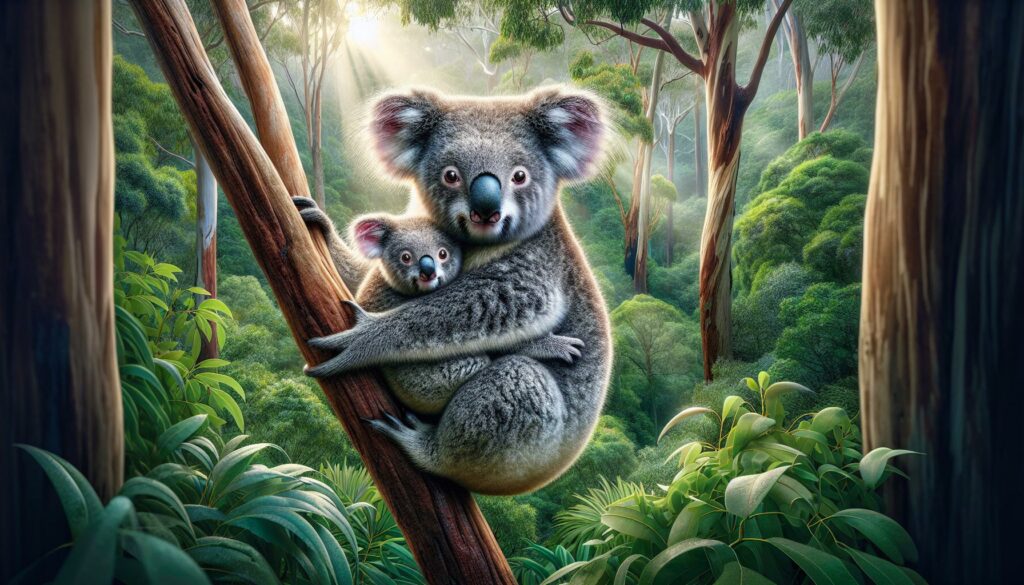When I think of adorable animals, koalas always come to mind. These cuddly creatures, often seen lounging in eucalyptus trees, have a charm that captures hearts worldwide. But it’s not just their cute faces that fascinate me; it’s also their unique behaviors and lifestyle that make them truly special.
In this article, I’ll dive into the world of baby:kusnxmqvz7o= koala, exploring their early development and the bond they share with their mothers. From the moment they’re born, these tiny marsupials embark on an incredible journey, facing challenges and learning to thrive in their environment. Join me as we uncover the enchanting life of baby koalas and why they’re so vital to Australia’s ecosystem.
- Early Development: Baby koalas, or joeys, are extremely small at birth, relying on their mother’s pouch for nourishment and safety for the first six months of life.
- Bond with Mothers: The nurturing behaviors of mother koalas are essential for the survival of their young, forming a strong bond that influences the joeys’ growth and development.
- Unique Diet Transition: Initially dependent on their mother’s milk, baby koalas later consume fecal matter, known as “”pap,”” to acquire gut bacteria necessary for digesting eucalyptus leaves.
- Adaptations for Survival: Baby koalas are equipped with physical and behavioral traits that enhance their ability to thrive in eucalyptus forests, such as strong claws for climbing and instincts to cling to their mothers.
- Conservation Challenges: Baby koalas face numerous threats, including habitat loss due to urbanization and climate change, making conservation efforts vital for their survival.
- Ongoing Conservation Efforts: Initiatives like habitat restoration, public awareness campaigns, and wildlife rehabilitation are crucial for protecting baby koalas and ensuring the health of their ecosystems.
Baby:Kusnxmqvz7o= Koala
Baby:Kusnxmqvz7o= koalas represent a critical stage in the life cycle of koalas. These young marsupials are about the size of a peanut at birth, weighing around 0.5 grams. They rely entirely on their mother’s pouch for the first six months, where they receive nourishment and protection.
During the early months, baby koalas undergo significant development. They cling to their mothers, allowing them to move while remaining secure. At approximately six months, they begin to emerge from the pouch, growing stronger and more curious.
Koalas primarily feed on eucalyptus leaves, which contain essential nutrients and moisture. Baby koalas initially rely on their mother’s milk but gradually transition to consuming fecal matter known as “”pap”” in order to acquire the necessary gut bacteria to digest eucalyptus leaves.
Understanding the nurturing behaviors of mother koalas highlights the strong bond that forms between them and their young. This relationship plays a crucial role in the survival and growth of baby koalas, shaping their behaviors and instincts as they prepare for independent life.
Overall, the early development of baby:Kusnxmqvz7o= koalas showcases both their vulnerability and resilience, emphasizing the importance of preserving their natural habitat in Australia’s ecosystem.
Characteristics of Baby:Kusnxmqvz7o= Koala
Baby koalas exhibit distinct physical and behavioral characteristics that contribute to their unique nature. Understanding these traits reveals the adaptations that support their early development and survival.
Physical Features
Baby koalas, or joeys, begin their lives incredibly small, typically measuring about 2 centimeters in length and weighing around 0.5 grams. Their bodies are initially hairless, with a soft, velvety skin texture. As they grow, they develop a gray fur coat, which offers insulation and protection. Joeys possess large eyes, which help them sense light and dark, aiding in their transition to a more active lifestyle. Their tiny limbs and claws allow them to cling securely to their mother’s fur while they develop their strength. At around six months, they emerge from the pouch, showcasing a more defined shape and structure, ready to experience their environment.
Behavioral Traits
Behaviorally, baby koalas display several notable traits. At birth, they rely exclusively on their mother’s milk for nourishment, indicating a strong reliance on maternal care. During their first few months, they exhibit a natural instinct to cling to their mother, which fosters safety and comfort. As they grow, curiosity develops, prompting them to explore their surroundings while remaining close to their mother. A crucial behavioral milestone involves learning to consume “”pap,”” which is essential for gut health. This process allows them to adapt to their future diet of eucalyptus leaves. Additionally, baby koalas communicate with soft, high-pitched vocalizations to maintain connection with their mother, reinforcing their bond and ensuring survival in the wild.
Habitat of Baby:Kusnxmqvz7o= Koala
Baby koalas inhabit eucalyptus forests, which provide essential resources for their growth and development. These environments play a critical role in their early life stages, ensuring access to maternal care and nutritious food sources.
Natural Environment
Koalas thrive in specific regions of Australia characterized by dense eucalyptus forests. These forests provide shelter and sustenance. Eucalyptus trees serve as both habitat and primary food source, with over 600 species, though koalas primarily consume leaves from about 50 species. The structure of these forests creates a multi-layered canopy, offering protection from predators and harsh weather conditions. This natural environment supports the delicate balance required for the survival of baby koalas and promotes a healthy ecosystem.
Adaptations for Survival
Koalas have developed several adaptations to navigate their habitat successfully. Their sharp claws enable secure climbing on eucalyptus trees, providing access to leaves and safe resting places. Joeys, or baby koalas, possess instincts to cling to their mothers, ensuring safety as they explore their surroundings. Their slow metabolism aligns with a low-energy diet consisting primarily of eucalyptus leaves, which are tough and toxic for many animals. Additionally, the development of specialized gut bacteria occurs when they consume their mother’s fecal matter, or “”pap,”” allowing them to digest these leaves efficiently. These adaptations are crucial for their survival in the wild, enabling them to thrive in their unique habitat.
Conservation Status of Baby:Kusnxmqvz7o= Koala
The conservation status of baby koalas is critical, reflecting the challenges they face in their natural habitats. Understanding the threats and the ongoing conservation efforts provides insight into ensuring their survival.
Threats to Their Population
Baby koalas face multiple threats that endanger their population. Habitat loss poses the most significant risk, driven by urbanization, agriculture, and logging. Deforestation reduces the availability of eucalyptus trees, crucial for their nourishment and shelter. Climate change exacerbates these issues, leading to habitat degradation and increased vulnerability to extreme weather events. Additionally, disease outbreaks, such as chlamydia, threaten their health and reproductive success, impacting population numbers. Road traffic and predation from domestic animals further compound these challenges, making survival increasingly difficult for young koalas.
Conservation Efforts
Numerous conservation efforts focus on protecting baby koalas and their habitats. Organizations work to restore eucalyptus forests by planting native trees and protecting existing ecosystems. Habitat preservation initiatives aim to create wildlife corridors that mitigate the impacts of urban development, allowing koalas safe passage between fragmented habitats. Public awareness campaigns educate communities about the importance of koala conservation, encouraging responsible pet ownership and habitat protection. Additionally, wildlife rehabilitation centers provide care for sick and injured koalas, ensuring that young koalas receive necessary medical treatment. Government policies, including the establishment of protected areas and stricter regulations on land clearing, further support conservation efforts aimed at preserving baby koalas and their environments.
Journey of Baby Koalas
The journey of baby koalas is nothing short of fascinating. From their tiny beginnings in the safety of their mother’s pouch to their gradual exploration of the eucalyptus forests, these little joeys capture my heart. Their reliance on maternal care and the adaptations they’ve developed for survival highlight the incredible bond between mother and young.
As I reflect on the challenges facing these adorable creatures, I feel a sense of urgency. Protecting their habitat and supporting conservation efforts is crucial for their future. By raising awareness and taking action, we can help ensure that baby koalas thrive in their natural environment for generations to come.

